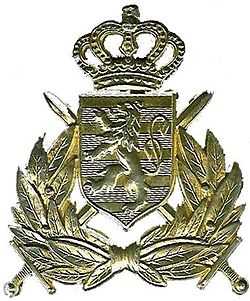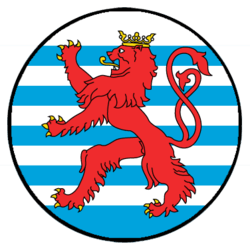Luxembourg Army
| Luxembourg Army Lëtzebuerger Arméi, Armée luxembourgeoise, Luxemburger Armee | |
|---|---|
|
Cap Badge of the Luxembourg Army | |
|
Roundel of the NATO Air Component | |
| Founded | 16 February 1881 |
| Current form | 29 June 1967 |
| Headquarters | Military Centre, Diekirch |
| Leadership | |
| Commander-in-Chief | Grand Duke Henri |
| Minister for Defence | Etienne Schneider |
| Chief of Defence | Romain Mancinelli |
| Manpower | |
| Military age | 18-24 |
| Available for military service |
118,665 males, age 16-49 (2010 est.), 117,456 females, age 16-49 (2010 est.) |
| Fit for military service |
97,290 males, age 16-49 (2010 est.), 96,361 females, age 16-49 (2010 est.) |
| Reaching military age annually |
3,263 males (2010 est.), 3,084 females (2010 est.) |
| Expenditures | |
| Budget | 279 million $ (2011)[1] |
| Percent of GDP | 0.5% (2011) |
| Related articles | |
| History | Military history of Luxembourg |
| Ranks | see Grades and insignia |
The Luxembourg Army is the national military of Luxembourg. Luxembourg has no navy, as the country is landlocked, or air force, although it does have aircraft. The Luxembourg Army was integrated into the Force Publique (Public Force) which included the Gendarmerie and the Police. The Gendarmerie was merged into the Grand Ducal Police in 2000. The army has been an all-volunteer force since 1967.[2] It has a current strength of approximately 450 professional soldiers, 340 enlisted recruits and 100 civilians, and a total budget of $369 million, or 0.9% of GDP.
The army is under civilian control. The Commander-in-Chief is the Grand Duke. The professional head of the army is the Chief of Defence, currently Mario Daubenfeld. He answers to the civil Minister for Defence in the civilian government, currently Etienne Schneider. The Grand Duke and the Chief of Defence are the only generals, with colonels as Deputy Chief of Defence and head of the Military Training Centre.
Luxembourg has participated in the Eurocorps since 1994, has contributed troops to the UNPROFOR and IFOR missions in former Yugoslavia, and participates with a small contingent in the current NATO SFOR mission in Bosnia and Herzegovina. The Luxembourg army is integrated into the Multinational Beluga Force under Belgian command. Luxembourg troops have also deployed to Afghanistan to support ISAF. Luxembourg has financially supported international peacekeeping missions during the 1991 Gulf War, in Rwanda and, more recently, Albania. The army also has participated in humanitarian relief missions such as setting up refugee camps for Kurds and providing emergency supplies to Albania.
History
Militia (1817–1841)
On 8 January 1817, the Grand Duke of Luxembourg, William I published a constitutional law governing the organization of a Militia, the main provisions of which were to remain in force until the Militia was abolished in 1881.[3] The law fixed the militia's strength at 3,000 men.[3] Up until 1840, Luxembourg’s militiamen served in units of the Royal Netherlands Army.[3] Enlisted men served for 5 years, although only the first year consisted of active service, whereas for the subsequent 4 years they were only mobilised 3 times per year.[3]
Federal contingent (1841-1867)
In 1839 William I became a party to the Treaty of London: the Grand-Duchy lost its western, francophone territories to Belgium, now the province of Luxembourg.[4] The militia lost half of its strength, due to the country having 160,000 inhabitants.[4] Under the terms of the Treaty, Luxembourg and the newly formed Duchy of Limburg, both members of the German Confederation, were together required to provide a Federal Contingent distributed among a Light Infantry Battalion garrisoned in Echternach, a Cavalry Squadron in Diekirch, and an Artillery detachment in Ettelbruck.[4] In 1846 the Cavalry and Artillery units were disbanded and the Luxembourg Contingent was separated from the Limburg Contingent.[4] The establishment was now two Light Infantry Battalions, the first Battalion in Echternach and the second in Diekirch, two reserve Companies and a depot Company.[4]
In 1866, the Austro-Prussian war resulted in the dissolution of the German Confederation. In the 1867 Treaty of London, Luxembourg was declared neutral in perpetuity, and its fortress was demolished over the following years in accordance with the Treaty. The Prussian garrison left the fortress that year, and the two battalions of Luxembourgish light infantry entered the city of Luxembourg in September 1867.[4]
A new military organization was established in 1867 with two Battalions known as the Corps des Chasseurs Luxembourgeois, with a total strength of 1,568 officers and men.[5] In 1868 the contingent became one Light Infantry Battalion of 4 Companies, with a strength of 500 men. On 16 February 1881, the Light Infantry Battalion was disbanded with the abolition of the militia-based system.[5]
Gendarmes and Volunteers Corps

On 16 February 1881 the Corps des Gendarmes et Volontaires (Gendarmes and Volunteers Corps) was established. The Corps comprised two Companies, a Company of Gendarmes and a Company of Volunteers. In 1939 a corps of Auxiliary Volunteers was established and attached to the Company of Volunteers. Following the occupation of Luxembourg by Germany on the 10 May 1940, recruitment for the Company of Volunteers continued until 4 December 1940 when they were moved to Weimar in Germany to be trained as German police.
Luxembourg Battery
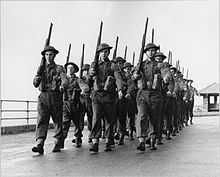
During World War II, the Luxembourg Government in exile in London made agreements for a group of seventy Luxembourg volunteers to be assigned in 1944 to the Artillery Group of the 1st Belgian Infantry Brigade, commonly known as the Brigade Piron.[6] This contingent was named the "Luxembourg Battery". Initially it was under Belgian officers; later, from August 1944, these were joined by Luxembourgish officers, who had received officer training in Britain.[6]
The Luxembourg Battery was equipped with four Ordnance QF 25 pounder howitzers, each of which was named after the children of Grand Duchess Charlotte: Princesses Elisabeth, Princess Marie Adelaide, Princess Marie Gabriele and Princess Alix.[6]
Of the Luxembourgers, several of the NCOs and half of the troops had fought in North Africa in the French Foreign Legion.[6] The rest were people who had escaped from Luxembourg, and young men who were evading forcible conscription into the Wehrmacht by fleeing to Britain.[6] The Luxembourg unit landed in Normandy on 6 August 1944, two months after the D-Day landings.
Post-Liberation Luxembourg Army
In 1944 obligatory military service was introduced. In 1945, the Corps de la Garde Grand Ducale (Grand Ducal Guard Corps), garrisoned in the Saint-Esprit barracks in Luxembourg City and the 1st and 2nd Infantry Battalions were established, one in Walferdange and the other in Dudelange. The Luxembourg Army took charge of part of the French zone of occupation in Germany, the 2nd Battalion occupying part of the Bitburg district and a detachment from the 1st Battalion part of the Saarburg district. The 2nd Battalion remained in Bitburg until 1955. Luxembourg signed the Treaty of Brussels in March 1948, then the North Atlantic Treaty in 1949.
In 1951 the Grand Ducal Guard was relocated to Walferdange and integrated with the Commandement des Troupes. The Grand Ducal Guard had special units for reconnaissance, anti-air warfare and radiac reconnaissance. From 1955 the Guard was organised into a Headquarters Company, a Garrison Platoon, a Reconnaissance Company and two Training Companies. In 1959 the Commandement des Troupes was disbanded and the Grand Ducal Guard was integrated into the Commandement du Territoire (Territorial Command). The establishment was reduced to a single Company, a Corporals' Training School and a Weapons Platoon. In 1960 the Grand Ducal Guard was again reorganised into four Platoons temporarily grouped into intervention and reinforcement detachments. In 1964 the Grand Ducal Guard was organized into a HQ, three Platoons, a reinforcement Platoon and the NCO school.
On the 28 February 1966 the Grand Ducal Guard was officially disbanded.
Korean War
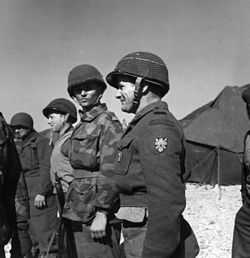
In 1950 seventeen countries, including Luxembourg, decided to send armed forces to assist the Republic of Korea. The Luxembourg contingent was incorporated into the 'Belgian United Nations Command' or the 'Korean Volunteer Corps'. The Belgo-Luxemburgish battalion arrived in Korea in 1951 and was attached to the US 3rd Infantry Division. Two Luxemburger soldiers were killed and 17 were wounded in the war. The Belgo-Luxemburgish battalion was disbanded in 1955.
Groupement Tactique Régimentaire and Home Command
In 1954 the Groupement Tactique Régimentaire (GTR), (Regimental Tactical Group) was established as Luxembourg’s contribution to NATO and consisted of three Infantry Battalions, an Artillery Battalion, a Services Company, a Medical Company, a Transport Company, a Signals Company, a Company of Engineers, a Heavy Mortar Company, a Reconnaissance Company and a Headquarters Company.
In addition to the GTR, the Army also included the Home Command comprising a Headquarters Company, a Company of Military Police, a Movements and Transportation Company, a Static Guard Battalion, and a Mobile Battalion. The GTR was disbanded in 1959.
1st Artillery Battalion
In 1961, the 1st Artillery Battalion was placed at NATO’s disposal. The battalion was organised as three Gun Batteries, each with six 105 mm field howitzers (British 25 pounder guns converted to 105 mm caliber) from the former GTR Artillery Battalion, a HQ Battery and a Service Battery. In 1963, the Battalion was attached to the US 8th Infantry Division. In 1966 the Grand Ducal Guard was disbanded and its taskings transferred to and performed by the Artillery Battalion. The 1st Artillery Battalion was disbanded in 1967.
1st Infantry Battalion
Compulsory military service was abolished in 1967 and the 1st Infantry Battalion was established comprising a Headquarters and Services unit, two Motorized Infantry Companies and a Reconnaissance Company with two Recce Platoons and an Anti-Tank Platoon. From 1968 onwards it formed a part of NATO’s ACE Mobile Force (Land) (AMF(L)). In 1985 the Battalion was replaced by a reinforced company consisting of an AMF Company with two Recce Platoons and an Anti-Tank Platoon, a Forward Air Control team, a National Support Element for logistics and a Medical Support element. In 2002 the AMF(L) was dissolved.
Luxembourg Army Organization
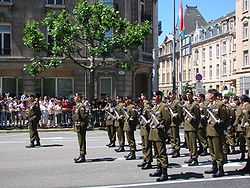
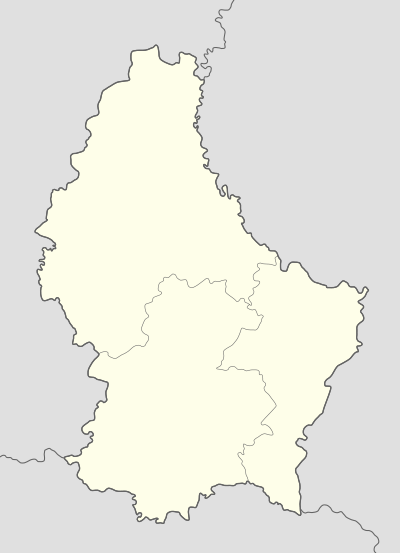
A - D (Diekirch)
The army of Luxembourg is a battalion sized formation with four separate companies which come under the control of the Centre Militaire (Military Centre), located in the "Caserne Grand-Duc Jean" barracks in the town of Diekirch.
Compagnie A
Compagnie A is the first of two rifle companies and it forms the Luxembourg contingent of the Eurocorps and will normally be integrated into the Belgian contribution during operations. As such it participates in Eurocorps' contribution to the NATO Response Force (entire company) and the EU Battlegroups (one platoon). The company consists of a command element and three reconnaissance platoons of four sections each plus a command section. Each section is equipped with two armored M1114 HMMWV armed with a .50 M2 Browning machine gun. The command section has a MAN X40 truck in addition to its pair of HMMWVs.
Reconversion Service
Compagnie B was the educational unit of the army, providing various educational courses for personnel to take in preparation for advancement. On May 19, 2011 Company B was redesignated as the Service de Reconversion (Reconversion Service) with the mission to prepare volunteer soldiers for the return to civilian life.[7] The service includes the L'Ecole de l'Armee (Army School). In order to attend this school a soldier must have at least 18 months of service. The School is divided into two sections:
- Level B - this is open for all soldiers at the end of their first 18 months of service. Soldiers follow two six-month periods of tuition in both general and military based subjects prior to taking examinations. Upon gaining 75% pass marks, they can proceed to the next level.
- Level A - Level A is open to soldiers who have achieved the required passes at Level B, or who have gained the equivalent in civilian life prior to their enlistment. Soldiers do a single six-month period of tuition in the same subjects as Level B, but for longer each week.
Compagnie Commandement et Instruction
The Compagnie Commandement et Instruction (Staff & Instruction Company) is the main military training unit of the Luxembourg Army, with instruction given in:
- Basic soldiering
- Driving
- Physical training
The Company is also responsible for the army's Elite Sports Section - this is for sportsmen who choose to join the army. Following their basic training, they join the Section de Sports d'Elite de l'Armée (SSEA).
Compagnie D
Compagnie D is the second rifle company - it provided Luxembourg's contribution to NATO's ACE Mobile Force (Land) (disbanded in 2002) as the Luxembourg Reconnaissance Company. Luxembourg's participation in various UN, EU and NATO missions is drawn from Compagnie D. As a rifle company, it mirrors Compagnie A in organisation, with a command element and three reconnaissance platoons.
Special Forces of Luxembourg
Luxembourg has two reconnaissance platoons, declared to NATO's Allied Mobile Force. They are elite rather than special forces.
The Grand Ducal Police has the Unité Spéciale de la Police.
Appearance
Luxembourg military uniforms are similar to British uniforms. The military had dress, service or garrison, and field uniforms. Dress uniforms were worn mostly on formal occasions. The service uniform was worn for daily duty. Luxembourg Army uniforms consisted of service and field attire for both summer and winter and a dress uniform and mess jacket for officers. The winter service dress uniform, of olive drab wool, consisted of a single-breasted coat having patch pockets with flaps, a khaki shirt and tie, and trousers that were usually cuffless. The summer uniform was similar but was made of light tan material. Combat uniforms in olive-green, khaki-drab, or woodland camouflage pattern, worn with the United States PASGT helmet, are virtually indistinguishable from those worn until the 1990s by the United States Army
Careers
Officers
Those who have completed high school will enter a special 13-week-basic training in the army as warrant officer, thus visiting the military officer school after for 5 years (normally in Brussels, Belgium), before becoming a lieutenant in the Luxembourg army.
Apsiring officers are sent to the Belgian École Royale Militaire in Brussels, or the Ecole Spéciale Militaire de Saint-Cyr in France. After the two first years at these schools, officer-cadets receive the title of lieutenant.[8]
After leaving the above schools, the office candidates become probationary officers for a period of 24 months.[8] The probation period is composed of specialised military branch training at a school abroad, and practical service within one of the Army's units. If they succeed this probation, their appointment as lieutenants is made permanent.[8]
NCOs
Those who have completed five years of high school and have served a 4 months as voluntary soldier, will do a 9-month-stage at the Infantry Training Department of the Belgian Army in Arlon, before becoming a sergeant in the Luxembourg army.
Career corporals
Those who haven't completed five years of high school may, after 3 years of service, become career corporals in the Luxembourg Army, if they pass physical and mental tests. They also have to pass a part of the NCO School in Belgium.
Grades and insignia
.jpg)
Flag Officers
- General (there are two, the Grand-Duke wearing a sabre and a crown and the Chef d'Etat Major, wearing a sabre and a star)
Officers
- Colonel (a crown and three stars)
- Lieutenant-Colonel (a crown and two stars)
- Major (a crown and a star)
- Captain (three stars)
- First lieutenant (two stars)
- Lieutenant (one star)
Officer Cadet
- Officer Cadet (a red-yellow-red stripe)
Non-commissioned officers
- Adjudant-Major (three yellow chevrons, two yellow stripes and a little yellow circle in the center)
- Adjudant-Chief (three yellow chevrons and two yellow stripes)
- Adjudant (three yellow chevrons and one yellow stripe)
- Chief-Sergeant (three yellow chevrons)
- First sergeant (two yellow chevrons)
- Sergeant (one yellow chevron)
Career corporals
- First chief corporal (one yellow chevron, three red chevrons and one red stripe)
- Chief corporal (one yellow and three red chevrons)
- First corporal (one yellow and two red chevrons)
- Corporal (one yellow and one red chevron)
Volunteer soldiers
- First chief soldier (three red chevrons)
- Chief soldier (two red chevrons)
- First soldier (one red chevron)
- Soldier (no insignia)
Equipment
Weapons
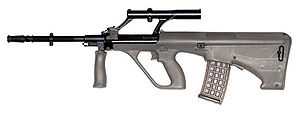
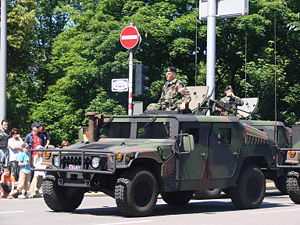
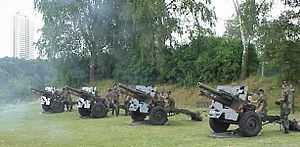
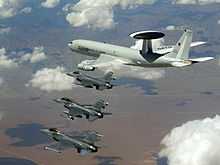
-
 Glock 17 9x19mm Parabellum pistol (Service pistol): Replaced Browning Hi-Power pistol
Glock 17 9x19mm Parabellum pistol (Service pistol): Replaced Browning Hi-Power pistol -
 Steyr AUG 5.56x45mm NATO rifle (Service rifle): Can be fitted with UA/1116 or KITE night sight, replaced FN FAL rifle
Steyr AUG 5.56x45mm NATO rifle (Service rifle): Can be fitted with UA/1116 or KITE night sight, replaced FN FAL rifle -
 Steyr AUG HBAR 5.56x45mm NATO automatic rifle
Steyr AUG HBAR 5.56x45mm NATO automatic rifle -
.svg.png) FN MAG 7.62x51mm NATO machine gun: Can be fitted with KITE night sight
FN MAG 7.62x51mm NATO machine gun: Can be fitted with KITE night sight -
 M2 Browning machine gun .50 BMG
M2 Browning machine gun .50 BMG -
 105 mm howitzer: (Re-barreled 25 pdr. guns) for ceremonial purposes
105 mm howitzer: (Re-barreled 25 pdr. guns) for ceremonial purposes -
 M72 Light Anti-tank Weapon (LAW)
M72 Light Anti-tank Weapon (LAW) -
 BGM-71 TOW missiles: Replaced the M40 recoilless rifle
BGM-71 TOW missiles: Replaced the M40 recoilless rifle
Vehicles
-
 Humvee vehicles, armoured and unarmoured (including 42 armoured M1114 HMMWV)[9]
Humvee vehicles, armoured and unarmoured (including 42 armoured M1114 HMMWV)[9] -
 Jeep Wrangler Rubicon: 15[10]
Jeep Wrangler Rubicon: 15[10] -
 MB 300D 4x4 (1st generation)
MB 300D 4x4 (1st generation) -
 MAN X40 trucks 4x4 and 6x6[11]
MAN X40 trucks 4x4 and 6x6[11] -
 Dingo 2 PRV (protected reconnaissance vehicle): 45[12][13] armed with a .50 M2 Browning machine gun in a Protector remote weapon system, and fitted with Thales observation system
Dingo 2 PRV (protected reconnaissance vehicle): 45[12][13] armed with a .50 M2 Browning machine gun in a Protector remote weapon system, and fitted with Thales observation system -
 Scania G480 8x8: 31 partially with ballistic protection system[14][15]
Scania G480 8x8: 31 partially with ballistic protection system[14][15]
Aircraft
NATO-owned
NATO acquired 18 Boeing E-3As and support equipment for a NATO air defense force. Since all aircraft must be registered with a certain country, the decision was made to register the 18 NATO AWACS planes with Luxembourg, because until that point Luxembourg did not have an air force. The first NATO E-3 was delivered in January 1982. Presently 17 NATO E-3As are in the inventory, since one NATO E-3 was lost in a crash. The 20 aircraft of the NATO AEW Force are all registered to Luxembourg, flown by NATO pilots, and based at the NATO Air Base Geilenkirchen.
| Aircraft | Origin | Type | Versions | In service | Notes |
|---|---|---|---|---|---|
| Boeing CT-49A[16] | |
NATO Trainer Cargo Aircraft (TCA) | CT-49A (707-329C) | 2 | Modified military version of the Boeing 707-329C, specifically the CT-49A version of the Boeing C-137 Stratoliner. |
| Boeing E-3A[16] | |
NATO AWACS/AEW&C Aircraft | E-3A Sentry | 17 | Military version (AWACS) of the Boeing 707-300, specifically the E-3A Sentry version of the Boeing C-137 Stratoliner. |
Luxembourg-owned
The government of Luxembourg has ordered 1 Airbus A400M transport aircraft in cooperation with the Belgian Air Component. The aircraft will be delivered in 2019.
| Aircraft | Origin | Type | Versions | Ordered | In service | Notes |
|---|---|---|---|---|---|---|
| Airbus A400M | |
Transport | A400M | 1 | 0 | On order. Due to be delivered in 2019.[17][18] |
Retired Luxembourg Army Aviation aircraft
| Aircraft | Origin | Type | Versions | Operated | In service | Notes |
|---|---|---|---|---|---|---|
| Piper PA-18 Super Cub | |
Trainer, Liaison aircraft | L-18C | 3 | 0 | Entered service in 1952. Retired in 1968.[19] |
Communications equipment
- VHF/PR4G: TRC-9100, TRC-9200V, TRC-9300B and TRC-9500
Former Equipment
- Rifles
- Karabiner 98k 7.92x57mm IS
- Ross rifle .303 British
- Pattern 1914 Enfield .303 British
- Lee-Enfield .303 British
- FN Model 1949 .30-06 Springfield
- FN FAL 7.62x51mm NATO
- Pistols and Revolvers
- Webley Revolver .38-200
- Browning Hi-Power 9x19mm Parabellum
- M1911 pistol .45 ACP
- Submachine guns
- Sten 9x19mm Parabellum
- Thompson submachine gun .45 ACP
- Sola submachine gun 9x19mm Parabellum
- Uzi 9x19mm Parabellum
- Machine guns
- Anti Tank
- Boys anti-tank rifle .55 Boys
- PIAT
- Bazooka
- M18 recoilless rifle
- M20 recoilless rifle
- M40 recoilless rifle
- 2-inch mortar
- Ordnance ML 3 inch Mortar
- M19 mortar
- M1 mortar
- M2 4.2 inch mortar
- L16 81mm Mortar
Notable soldiers
- Émile Hamilius
- Bodry Gretsch
- Tessy Antony, born 1985, is among the more prominent former members of Luxembourg's military. From March to July 2004 she took part in a mission in Mitrovica, Former Yugoslavia as part of KFOR, the NATO peacekeeping force in Kosovo. In 2006 she married Prince Louis of Luxembourg, with whom she has two sons, Princes Gabriel and Noah. She is styled "Son Altesse Royale Princesse Tessy de Luxembourg".
Footnotes
- ↑ Defence Expenditures of NATO Countries (1990-2011)
- ↑ "Mémorial A, 1967, No. 43" (PDF) (in French). Service central de législation. Retrieved 2006-09-11.
- ↑ 3.0 3.1 3.2 3.3 "La Milice (1817-1841)". Armee.lu. Armée luxembourgeoise / Gouvernement du Grand-Duché de Luxembourg.
- ↑ 4.0 4.1 4.2 4.3 4.4 4.5 "Le Contingent Fédéral (1841-1867)". Armee.lu. Armée luxembourgeoise / Gouvernement du Grand-Duché de Luxembourg.
- ↑ 5.0 5.1 "Le Corps de Chasseurs Luxembourgeois (1867-1881)". Armee.lu. Armée luxembourgeoise / Gouvernement du Grand-Duché de Luxembourg.
- ↑ 6.0 6.1 6.2 6.3 6.4 "Les Luxembourgeois de la "Brigade Piron"". Armee.lu. Armée luxembourgeoise / Gouvernement du Grand-Duché de Luxembourg.
- ↑ "Service de Reconversion". Armee.lu. Armée luxembourgeoise / Gouvernement du Grand-Duché de Luxembourg.
- ↑ 8.0 8.1 8.2 "Officiers de carrière: Engagement – Formation – Nomination". Armee.lu. Armée luxembourgeoise / Gouvernment du Grand-Duché de Luxembourg.
- ↑ PICTURE http://www.armyrecognition.com/europe/Belgique/exhibition/Active_Lion/images/Active_Lion_2005_Belgium_Army_10.JPG
- ↑ "Looking for luxembourg soldiers - Page 8". Retrieved 23 October 2014.
- ↑ PICTURE http://www.armyrecognition.com/europe/Belgique/exhibition/Active_Lion/images/Active_Lion_2005_Belgium_Army_08.JPG
- ↑
- ↑ http://www.wort.lu/wort/web/letzebuerg/artikel/2010/06/98079/neue-dienstwagen-fuer-die-polizei.php
- ↑ "Commercialmotor.com - Scania gets its call-up papers for over 100 military trucks! Biglorryblog salutes a Swedish 8x8 bruiser...". Retrieved 23 October 2014.
- ↑
- ↑ 16.0 16.1 NATO military aviation OrBat
- ↑ "Airbus’ A400M Aerial Transport: Delays and Development". 2012-07-10. Retrieved 2013-01-11.
- ↑ "A400M (Future Large Aircraft) Military Transport Aircraft". 2013-01-11. Retrieved 2013-01-11.
- ↑ "Info on retired Luxembourg Army Aviation aircraft (Piper Super Cubs) active during the 1950s and 1960s". 2013-01-11. Retrieved 2013-01-11.
External links
| Wikimedia Commons has media related to Military of Luxembourg. |
| ||||||||||||||||||||
| ||||||
| ||||||||||||||
